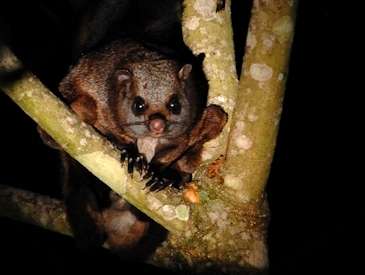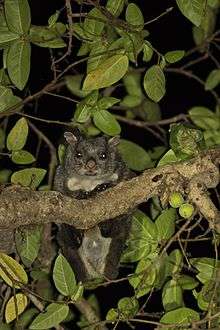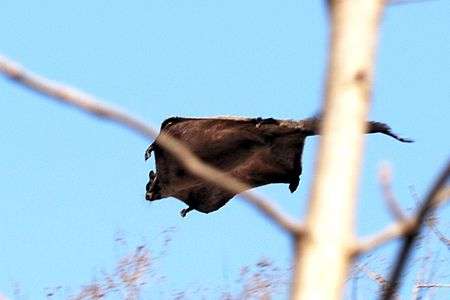Indian giant flying squirrel
| Indian Giant Flying Squirrel | |
|---|---|
 | |
| Scientific classification | |
| Kingdom: | Animalia |
| Phylum: | Chordata |
| Class: | Mammalia |
| Order: | Rodentia |
| Family: | Sciuridae |
| Genus: | Petaurista |
| Species: | P. philippensis |
| Binomial name | |
| Petaurista philippensis (Elliot, 1839) | |
The Indian giant flying squirrel (Petaurista philippensis), also called the large brown flying squirrel or the common giant flying squirrel, is a species of rodent in the Sciuridae family. It is capable of gliding flight using a skin membrane strecthed between front and hind legs. It is found in mainland Southeast and South Asia, and southern and central China.
Description

This is a large species, with a head and body length of about 43 cm and a tail of 50–52 cm. It has black to gray-brown fur, long and soft on the upper parts and somewhat shorter underneath the body, with a grizzled appearance. A wing membrane between the forelimb and hindlimb, paler coloured underneath, allows gliding between trees. The tail is hairy and blackish to gray-brown, the feet are black, and the nose is pale pink with black vibrissae.[2]
Distribution and habitat

The species is native to China, India, Laos, Myanmar, Sri Lanka, Taiwan, Thailand, and Vietnam. It inhabits dry deciduous and evergreen forests, usually at higher elevations from 500m-2000m, and has been recorded on plantations.[1]
Ecology
The Indian giant flying squirrel is nocturnal and arboreal, spending most of its life in the canopy. Nests are made in tree hollows lined with bark, fur, moss, and leaves. The species is sociable when food is abundant, but intraspecies attacks increase with food scarcity. Vocalizations are similar to those of the spot-bellied eagle-owl.[2]
Diet
The species is mainly frugivorous, preferring the fruits of Ficus racemosa, followed by Cullenia and Artocarpus heterophyllus. It also takes bark, tree resins, shoots, leaves (particularly of F. racemosa), insects, and larvae. Squirrels were shown to be somewhat tolerant of disturbance when foraging, and to exploit food resources at the forest edge, including exotic planted species.[3]
Reproduction
Female gives birth to a single offspring during mid June. Pups born blind, with a head thatis disproportionately large when compared with the body.[2]
References
- 1 2 Walston, J., Duckworth, J.W. & Molur, S. (2016). "Petaurista philippensis". IUCN Red List of Threatened Species. IUCN. 2016: e.T16724A22272037. Retrieved 5 April 2017.
- 1 2 3 Yapa, A.; Ratnavira, G. (2013). Mammals of Sri Lanka. Colombo: Field Ornithology Group of Sri Lanka. p. 1012. ISBN 978-955-8576-32-8.
- ↑ Nandini, R.; Parthasarathy, N. (2008). "Food habits of the Indian giant flying squirrel (Petaurista philippensis) in a rain forest fragment, Western Ghats". Journal of Mammalogy. 89 (6): 1550–1556. doi:10.1644/08-mamm-a-063.1.
Further reading
- Koli, VK.; Bhatnagar, C; Mali, D. (2011). "Gliding behaviour of Indian Giant Flying Squirrel Petaurista philippensis Elliot" (PDF). Current Science. 100 (10): 1563–1568.
- Nandini, R.; Parthasarathy, N. (2008). "Food habits of the Indian Giant Flying Squirrel (Petaurista philippensis) in rain forest fragment, Western Ghats" (PDF). J. Mammal. 89 (6): 1550–1556. doi:10.1644/08-mamm-a-063.1.
- Koli, VK.; Bhatnagar, C; Sharma, S.K. (2013). "Distribution and status of Indian Giant Flying Squirrel (Petaurista philippensis Elliot) in Rajasthan, India". Natl. Acad. Sci. Lett. 36 (1): 27–33. doi:10.1007/s40009-012-0105-z.
